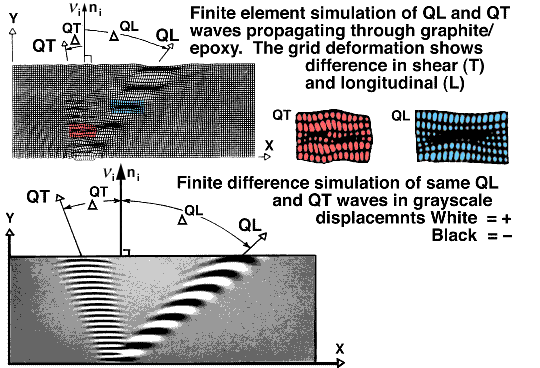==============================================================

ANIMATION: ( MPEG(768K) )
Instructions for using this form:
Simulation results returned:
Below are images with
back-ground-info that describes this problem in more detail.
TERMS DEFINED
==============================================================

ANIMATION: (
MPEG(768K) )
How to Visually Interpret Results
==============================================================
BULK WAVE PROPAGATION SIMULATION IN UNIDIRECTIONAL Gr/Ep
----------------------------------------------------------------------------------------------------------------
Unlike isotropic materials waves propating in anisortropic materials deviate from
the wave normal ni. This anisotropy quides the wave energy propagation shown in
the animations provided above. From this simulation new relationships can be
seen: 1) the faster moving QL wave has a longer wavelength, 2) diffractions
from reflected bulk waves create Rayleigh surface waves, 3) the reflected QL
wave energy propagates back towards the origin, 4) this refection does not
generate another bifrucation of energy into yet another QL & QT wave. This
information suggests that waves could be launched preferentially.

Because a deformed mesh shows shows the wave types, L, QL, QT, or T,
more clearly, highlighted above as red and
blue regions, the animation
of simulation results are shown as a deformed mesh.
Below is specific information that describes how to use data in the
form shown in the lower frame.
__________________________________________________________________________
Simulated transducer defined by identifying grid nodes and vibration direction angles:
=========================================================================
View larger format

The FEM mesh size above cannot be changed in this module, however the
number of nodes that define the simulated
transducer (green) can be changed in the form provided in the lower
frame. At the bottom of the form the user can
select which nodes are active by altering the # Nodal Displ.,
e.g. change 21 to 11, in the first line on the form and the
corresponding Number of Elements in One Wavelength
which is one less that the total # Nodal Displ., e.g. change
20 to 10. The FEM program sets the Number of Elements in One
Wavelength equal to the transducer length
highlighted in green. For small transducers, e.g. 4 elements/wave
length, the corresponding L, QL, QT, or T waves
launched by the simulated transducer are equally small which gives rise
to dispersion, i.e. slower wave group velocities.
At 4 elements per wavelength the group velocity goes to zero. Next to
the node numbers defined at the bottom
of the form are the prescribed displacement directions in degrees which
is set at 00.0 degrees. At 00.0 degrees these
nodal displacements are restricted to move in the horizontal direction,
which generates transverse waves. If these
angles are set to 90.0 degrees these nodal displacements are restricted
to move in the vertical direction, which generates
longitidinal waves